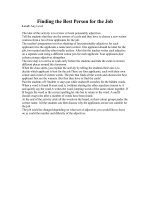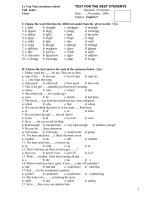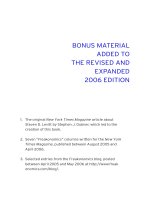the best irish drinks 2006 - foley
Bạn đang xem bản rút gọn của tài liệu. Xem và tải ngay bản đầy đủ của tài liệu tại đây (545.7 KB, 228 trang )
BEST
Irish Drinks
The
R a y F o l e y
Copyright © 2006, 1998 by Ray Foley
Cover and internal design © 2006 by Sourcebooks, Inc.
Cover photo credit: Getty Images
Sourcebooks and the colophon are registered trademarks of Sourcebooks, Inc.
All rights reserved. No part of this book may be reproduced in any form or by any
electronic or mechanical means including information storage and retrieval sys-
tems—except in the case of brief quotations embodied in critical articles or
reviews—without permission in writing from its publisher, Sourcebooks, Inc.
This publication is designed to provide accurate and authoritative information in
regard to the subject matter covered. It is sold with the understanding that the
publisher is not engaged in rendering legal, accounting, or other professional serv-
ice. If legal advice or other expert assistance is required, the services of a compe-
tent professional person should be sought.—From a Declaration of Principles
Jointly Adopted by a Committee of the American Bar Association and a
Committee of Publishers and Associations
All brand names and product names used in this book are trademarks, registered
trademarks, or trade names of their respective holders. Sourcebooks, Inc., is not
associated with any product or vendor in this book.
Published by Sourcebooks, Inc.
P.O. Box 4410, Naperville, Illinois 60567-4410
(630) 961-3900
FAX: (630) 961-2168
www.sourcebooks.com
Library of Congress Cataloging-in-Publication Data
Foley, Ray.
[Spirits of Ireland]
The best Irish drinks / Ray Foley.
p. cm.
Originally published: The spirits of Ireland. [United States] : Foley Pub., c1998.
ISBN-13: 978-1-4022-0678-8
ISBN-10: 1-4022-0678-X
1. Cocktails. 2. Bartending. 3. Alcoholic beverages—Ireland. I. Title.
TX951.F594 2006
641.8’7409417—dc22
2005025015
Printed and bound in the United States of America.
WC 10 9 8 7 6 5 4 3 2
Dedication
To John J. Foley Sr. (limerick), Ellen Josephine
(Russell) Foley (Tipperary), and Ryan Peter Foley, a
great Irish American.
Table of
Contents
Introduction
Irish Whiskey
. . . . . . . . . . . . . . . . . . . . . . . . . .1
Bushmills . . . . . . . . . . . . . . . . . . . . . . . . . . . . . .2
Connemara . . . . . . . . . . . . . . . . . . . . . . . . . . . .5
Jameson . . . . . . . . . . . . . . . . . . . . . . . . . . . . . . .6
Jameson 1780 . . . . . . . . . . . . . . . . . . . . . . . . . .9
Kilbeggan . . . . . . . . . . . . . . . . . . . . . . . . . . . .10
Midleton . . . . . . . . . . . . . . . . . . . . . . . . . . . . .11
Paddy . . . . . . . . . . . . . . . . . . . . . . . . . . . . . . .12
Powers . . . . . . . . . . . . . . . . . . . . . . . . . . . . . . .12
Tullamore Dew . . . . . . . . . . . . . . . . . . . . . . . .13
Tyrconnell . . . . . . . . . . . . . . . . . . . . . . . . . . . .19
Bit O’ the Others . . . . . . . . . . . . . . . . . . . . . .20
The Rest of the Best . . . . . . . . . . . . . . . . .21
Celtic Crossing . . . . . . . . . . . . . . . . . . . . . . . .22
Cork Dry Gin . . . . . . . . . . . . . . . . . . . . . . . . .23
Irish Mist . . . . . . . . . . . . . . . . . . . . . . . . . . . . .23
Mead . . . . . . . . . . . . . . . . . . . . . . . . . . . . . . . .26
Bunratty Mead . . . . . . . . . . . . . . . . . . . . . . . .29
Poteen . . . . . . . . . . . . . . . . . . . . . . . . . . . . . . .30
Hackler . . . . . . . . . . . . . . . . . . . . . . . . . . . . . .31
Irish Creams . . . . . . . . . . . . . . . . . . . . . . . . .33
Ashbourne . . . . . . . . . . . . . . . . . . . . . . . . . . . .34
Baileys . . . . . . . . . . . . . . . . . . . . . . . . . . . . . . .34
Carolans . . . . . . . . . . . . . . . . . . . . . . . . . . . . .36
Devonshire . . . . . . . . . . . . . . . . . . . . . . . . . . .40
O’Mara’s . . . . . . . . . . . . . . . . . . . . . . . . . . . . .40
Saint Brendan’s . . . . . . . . . . . . . . . . . . . . . . . .41
Beer—Stout—Lager . . . . . . . . . . . . . . . . .43
Beamish . . . . . . . . . . . . . . . . . . . . . . . . . . . . . .44
Guinness . . . . . . . . . . . . . . . . . . . . . . . . . . . . .44
Harp Lager . . . . . . . . . . . . . . . . . . . . . . . . . . .48
Murphy’s Irish Amber . . . . . . . . . . . . . . . . . . .49
Irish Cocktails . . . . . . . . . . . . . . . . . . . . . . . .55
The Story of Irish Coffee . . . . . . . . . . .151
Toasts & Wisdoms . . . . . . . . . . . . . . . . . .155
Triads of Ireland . . . . . . . . . . . . . . . . . . . .181
Notes and Recipes . . . . . . . . . . . . . . . . . .200
About the Author . . . . . . . . . . . . . . . . . . .203
To all the suppliers who came forth with information
on their products:
Heineken USA
Brown-Forman Beverage Co.
C&C International, Ltd.
A. Hardy USA, Ltd.
Whitehall Advertising
IDV North America
Guinness Import Co.
Nancy Larkin, Camelot
Heaven Hill Distilleries, Inc.
Vince Piscopo, Wells, Rich, Greene
Stephen Davis, Heineken USA
John Vidal, Anita Galvin, Brown-Forman Beverage Co.
Alan Lewis, C&C International, Ltd.
William J. Walsh, A. Hardy USA, Ltd.
Patricia Bornmann, Whitehall Advertising
Michael L. Avitable, Marie Brizard Wines & Spirits
USA
Meg Syberg, David Sherman Corp.
Howard Pulchin, Guinness Import Company
Barry Berish, Michael Donahue, Jim Beam Brands Co.
Jim Cotter, Stephen L. Kauffman, Susan Overton,
Heaven Hill Distilleries, Inc.
Katie Bush, Keith Steer, Halbleib/Beggs, Inc.
Acknowledgments
Mark Doyle, Austin, Nichols & Co., Inc.
The Milton Samuels Agency
Karen Danik, Cairns & Associates, Inc.
Plus, Jaclyn Wilson Foley for her loyalty, Loretta
Natiello for being my best friend, J.K. for his assistance,
and all the great Irish bars and bartenders who con-
tributed to Bartender magazine with their great recipes.
viii
Introduction
God gave the recipe for whiskey to the people of Ireland
because he loved them. Among His treasures are a few
that are exceedingly rare, and one of these is the Water
of Life. “What better gift,” He asked Himself one fine
misty morning, “for these truly unusual and gifted peo-
ple?” No wonder they call it spirit.
In his customary oblique manner, the Almighty did
not simply appear by a Sligo bog one day with barley
under one arm and an alembic under the other. He
chose instead to instruct folks in a distant land—hazy
references mention “the East,” probably lands occupied
by the Mohammedans—in the art of distillation. The
stimulant of choice among these folks was coffee, and
they never tried their hand at distilling grains. Theirs is
the loss; they chose instead to distill fragrances.
It could have been any monk, or group of monks, but
some of the old folks insist it was St. Patrick who pock-
eted the formula for distillation on a visit to the East and
returned with it to the Emerald Isle in the fifth century.
Born in Britain, Patrick was captured and taken to
Ireland as a slave at age sixteen. He escaped six years
later, wandered around the continent, and eventually
took holy orders. The record of his visit to the East is
missing, but he might have been among those Christians
who travelled to the land of the infidel to spread the
gospel. In any event, he returned to Ireland, thrust him-
self and the teachings of the Roman church upon the
king at Tara, gave the snakes their marching orders, and
set up the first pot still. What a day.
It is impossible to imagine what the aqua vitae of
ancient Ireland tasted like. Doubtless, the quality of the
grains was high, but they had no idea what yeast was;
perhaps the early distillers saved some yeast from the
foam of the mash, an early stage of the whiskey-making
process, or else they relied on wild, airborne yeast. It is
probable that the first distillers also consumed their
whiskey soon after distillation. The idea of aging in
wood no doubt came after years of experimentation.
Whiskey history is obscure, but we know two things
for sure: it was a volatile and impure liquor, but it had
(and has) medicinal qualities.
The value of aqua vitae as a benefit to human health
was unquestioned. The quality of food and water
throughout the world was always in question.
Distillation, therefore, was a purification of matter, a
transformation of the ordinary into spiritual state. A
draught of the spirit could negate the impurities ingested
into the body during the normal course of a meal. It was
considered also to be a restorative remedy for sickness. We
know this from our grandmothers, yet the government of
x
this country seeks to quell all knowledge of this common
and delightful cure.
The other certainty was this: the high concentration
of impurities in homemade whiskey had the potential to
impart a ferocious headache and a stupendous hangover.
No wonder the Irish have a predilection for cabbage.
That vegetable is one of the few on earth that contains a
compound said to alleviate the discomfort encountered
on the morning after an evening of insobriety.
St. Patrick’s legacy influenced a nation steeped in
Catholic tradition and study. So renowned was Ireland
for its religious scholarship that it attracted priests and
monks from all Christendom. In most of the European
lands dotted with monasteries, the men who took holy
orders also took to making beer, wine, and spirits. It was
the Irish brothers, therefore, who slowly refined the art
of distillation, thereby refining the whiskey itself.
Make no mistake: the Irish were the world’s first
distillers of spirits. This is not to denigrate anything
Scottish; the Scotch whisky experience is as complex
and rewarding as that of Irish whiskey. But be it
known that the people of Ireland were distilling
whiskey at a time when the Picts, the predecessors of
the Scots (who came from Ireland in the first place),
were still smearing their bodies with blue paint and
stealing cattle in the Lowlands.
xi
Much of the history of Ireland contains events
unpleasant and disappointing to the Irish, which is yet
another reason God gave them the whiskey—so that
they could endure strife. It was one such unpleasantness
that gave the outside world its first taste of the Water of
Life. In the 1100s, King Henry II of England sent his
soldiers west to invade Hibernia—the first of many
unwelcome visits by the Crown. They burned and loot-
ed and inflicted the usual pain on the Irish people, but
they also discovered that the locals enjoyed something
they called uisge beatha. The British soldiers were not
cunning linguists and could not properly mouth the
Gaelic, so they bastardized the first word a few times
and, eventually, it came to be pronounced “whiskey.”
They also discovered that they enjoyed drinking it and
brought some home with them, to the delight of their
countrymen, and even became promoters of this saintly
liquor on their travels around the globe.
The rest of the history of Irish whiskey reads just like
the history of the rest of the world: the efforts of the gov-
ernment to suck taxes out of the people. By the 1500s,
the government in Ireland was English, and England
was ever in search of sources of revenue with which to
support its imperialistic expansion. Levying of punitive
laws and fees on illicit stills and distillers, and even on
raw materials used in making whiskey, increased over the
xii
next several centuries. The stills went underground, out
into the bogs, ever farther from the eye and reach of the
exciseman. It is safe to say that every village, and many
a farmstead, had an operating still. The “poteen” was
often wicked—clear spirit, unaged, impure, highly alco-
holic, but satisfying to the rebellious Irish soul.
In 1608, in County Antrim in what is now
Northern Ireland, the first legal distillery was born on
the banks of the River Bush. The fact that it was called
“Old Bushmills Distillery” gives ample indication that
the making of whiskey had gone on for some time in
the village of Bushmills. It is told that in 1276, Sir
Robert Savage, the local landlord, fortified his troops
with uisge beatha before they took to battle. The 1608
license was granted to Sir Thomas Phillips by King
James I, and the whiskey soon became a favorite
among the nobs of London society. Its popularity
spread and, within the next two centuries, the whiskey
made at Old Bushmills became a favourite in the
Western Hemisphere to the extent that most of the
distillery’s product was exported.
Fire destroyed the Old Bushmills Distillery in 1885,
gutting all but one building. The loss was devastating.
But the world needs whiskey, and the entire complex
was rebuilt and operating within three years. In 1897,
the distillery announced a special issue for Queen
xiii
Victoria’s Diamond Jubilee: ten thousand bottles of its
Pure Old Malt whiskey.
Two other great Irish distilleries were established in
Dublin, Ireland’s capital, in the late eighteenth century:
John Jameson & Son in 1780, and Sir John Power &
Son in 1791. Jameson is now the best-selling Irish
whiskey in the world. By the end of the 1800s, it is esti-
mated that more than four hundred registered brands of
Irish whiskey were available in the United States alone.
Meanwhile, the poitin men still operated in the back
country, smuggling in raw materials and smuggling out
their unlicensed whiskey. The uncountable little stills in
the hills and bogs gave rise to an army of excisemen and,
for more than a century, blood was shed on both sides
over the unlicensed distillation of uisge beatha.
The quality of the whiskey two hundred years ago
probably was not as high as it is today, because competi-
tion among distillers was causing them to push the prod-
uct out into the marketplace. Good whiskey must be
made slowly and with care, but the probable coarseness of
the whiskey back then was considered by the growing
anti-alcohol contingent to be a contributor to the social
ills. A government act in 1823 succeeded in placing strict
controls on the distillation process and, while this meant
more regulation and higher tariffs, it also meant a slower
distillation and a whiskey of higher quality.
xiv
Booming though it was, the nineteenth century saw the
beginnings of a long period of difficulty for the distillers of
Irish whiskey. This led to a dramatic decline in the twenti-
eth century from which the whiskey’s popularity had bare-
ly emerged. Though production remained high in the
1800s, several factors combined to start the slide. The con-
tinuous increase in duties on spirits was only one of them.
Another was competition from other intoxicating
beverages. Rum was a force to contend with, both in
England and in the Americas. Cognac and other
brandies were making inroads, and wine was well estab-
lished in Britain. A third factor was famine. Nothing
drove the Irish people from their homeland the way the
potato famines did. Couple that with the evictions from
their native soil by the landlords and it is not surprising
that in 1847, more than two hundred thousand Irish left
the island. Within a few years annual emigration was
more than a quarter million.
But the greatest of threats to pot-distilled Irish
whiskey was homegrown, born in the mind of Aeneas
Coffey of Dublin. For many years, Coffey had been an
exciseman, rising eventually to become inspector gener-
al of excise. After he resigned from government service
in 1824, he put his wits to work and invented what
became known as the Coffey still. This remarkable
invention allowed for continuous production of grain
xv
spirit that was just shy of pure alcohol. It remains near-
ly unchanged in design to this day.
The Coffey still incensed and disgusted the Irish
whiskey distillers. The big companies rejected it as an
adulteration. But across the water in Scotland and
England, the continuous still found a home. Soon the
production of grain whiskey began to flood the market
of the empire, but what was most offensive to the pot-
whiskey distillers was that the grain spirit was being
blended with a small amount of pure Irish whiskey and
sold, both abroad and at home, as the real thing.
Elsewhere in the British Empire, blended Scotch whisky
began its long rise in popularity, further dampening sales
of the Irish product.
For more than half a century, the Irish distillers and
their supporters fought against the blenders. Even doc-
tors came out on the side of the pot distillers, railing in
professional journals against health risks from consump-
tion of “fermented liquor made from damaged grain,
rotten potatoes, refuse molasses, or other waste.” The
cause in favor of whiskey purity was joined also by some
distillers of fine Scotch, who saw the blending craze
diminish their business as well.
Though the traditional distillers never won the blend-
ing war, two laws were set down in the first part of the
twentieth century that gave some benefit to the distillers
xvi
and consumers of fine whiskey. The first was that, hence-
forth, Irish whiskey could be made only in Ireland, and
Scotch whisky could be made only in Scotland. The
second was that all whiskey, whether distilled in the old
copper alembics or in the Coffey contraption, must
mature for a minimum of three years in wood. The
Coffey still people didn’t like that much, for it set back
their production three years, but the result was—and
is—a much better whiskey.
The early years of the twentieth century brought
Ireland its independence from England (1916), but not
without great cost. The 1919 partitioning of Ireland into
north and south gave rise to two years of civil war, followed
by economic war; England and Ireland closed their mar-
kets to each other. That shut off sales of Irish whiskey to
Canada, Australia, a great deal of Africa, India, New
Zealand, parts of the Far East, and parts of the Caribbean.
It is estimated that Irish whiskey sales in the British Empire
amounted to 25 percent of the whole business. That nice
slice of the economic pie went to Scotch whisky.
As if that wasn’t enough, the silly government on the
other side of the Atlantic shut off the legal trade in liquor
for fourteen long years, something they called Prohibition,
which turned out to have done more harm than good both
in the U.S. and abroad. Bootleggers had a picnic, and went
so far as to promote inferior products as “Irish whiskey,”
xvii
which damaged the reputation of the real thing. And when
the Prohibition ended in 1934, the producers of Irish
whiskey did not have enough product on hand to reenter
the U.S. market at once. Whiskey takes a long time to
mature. Stocks were low, and the Irish suffered again.
Irish whiskey languished, and the number of distill-
eries gradually shrunk to a handful. But lo, along comes
a trade endeavour to stir sales. Between 1966 and 1972,
the remaining five distilleries formed the Irish Distillers
Group, aiming to revitalise the global market for the
original Water of Life.
Since 1987, old distilleries have reopened and new
distillers are being opened as I write. New blends and
many more new and exciting products are coming from
this great land—Ireland.
Today we are comfortable with blended whiskey,
with the single malts, and with the assurance that we
can buy and savour fine Irish whiskey, the best that
Ireland has to offer. The Divine Distiller has done, and
continues to do, his part in blessing us with Irish
whiskey. The Irish, with their music and their stories
and poetry, have conquered our hearts, and with their
uisge beatha they have banished our thirst.
I hope the following pages of information will help
you enjoy the spirits of Ireland.
Slainte!
xviii
Publisher’s Note: This book and the recipes contained herein
are intended for those of a legal drinking age. Please drink
responsibly and ensure that you and your guests have a des-
ignated driver when consuming alcoholic beverages.
The author and Sourcebooks, Inc. shall have neither liability
nor responsibility to any person or entity with respect to any
loss, damage, or injury caused or alleged to be caused directly
or indirectly by the information in this book.
xix
whiskey
A Little Bit of Information
Bushmills
The Old Bushmills Distillery in County Antrim,
Ireland, is located in the heart of a lush barley-growing
area and along the banks of St. Columb’s Rill, a tribu-
tary of the River Bush.
The oldest licensed distillery in the world, the Old
Bushmills Distillery was founded in 1608, but even before
that date there was evidence of magic in the air; in 1276,
Sir Robert Savage, ground landlord of Bushmills, fortified
his troops before battle with “a mighty drop of aqua vitae.”
The Old Bushmills Distillery has always used the
agricultural riches surrounding it to produce a very spe-
cial spirit—and today it is the birthplace of four distinc-
tive whiskeys: Bushmills Premium Irish whiskey, Black
Bush Special Irish whiskey, Bushmills 10-Year-Old
Single Malt Irish whiskey, and Bushmills 16-Year-Old
Rare Single Irish Malt whiskey, a single malt Irish
whiskey finished in three different woods.
Like its production process, Bushmills’ ingredients
have stayed the same over the centuries. First there is
barley, which is examined, graded, and cleansed to per-
fection as malt. The malt is then dried in a closed kiln
kept separate from smoke; exposure of the barley to heat
brings a special smoothness to the spirit.
After the malt has mellowed for several weeks, it is
milled into grist. The grist is mixed with water from St.
2
Columb’s Rill at various temperatures and yeast is added
to the resulting mixture. Because the river flows over
beds of basalt, the water imparts a unique sweet flavour
to the distilled spirit.
All whiskeys produced at the Old Bushmills Distillery
are distilled three times in authentic copper pot stills.
The primary and secondary distillations remove impuri-
ties, while the third distillation helps create a smoother,
cleaner spirit and ensures the quality of the whiskey.
Bushmills Premium Irish Whiskey
The original and best-known whiskey from the Old
Bushmills Distillery is Bushmills Premium Irish whiskey.
Malt whiskey reserved for Bushmills is aged seven years
in oak casks specially selected to bring out the light, del-
icate characteristics of the whiskey. When mature, this
malt whiskey is blended with a single Irish grain that has
a light aroma and hint of sweetness. The result is golden
in color, smooth in texture, and delicate in flavour.
Black Bush Special Irish Whiskey
Black Bush Special Irish whiskey is a rich, dark blend that
is comprised of a high percentage of pure malt whiskey.
Malt whiskey that becomes Black Bush is aged nine to
eleven years in selected sherry-seasoned oak casks before
being blended with a small portion of a special single
3
grain whiskey to enhance the character of the malt.
The combination is then returned to the cask for
“marrying.” As the whiskeys mellow together, producing
a uniquely rounded bouquet and rich amber hue, the
distinctive taste of Black Bush is born.
Bushmills Single Malt Irish Whiskey—10 Years Old
Possessing a warm, sweet aroma and well-balanced
flavour, Bushmills Malt is a delicate whiskey crafted
from 100 percent malted barley.
The malt used to make Bushmills Malt is deliberate-
ly dried in closed kilns. This prevents the malt from
absorbing the fire’s smokiness (hence, no smoky flavours
are imparted to the final distilled spirit), while still
retaining the character of the malt.
Unlike its brethren Bushmills Irish whiskey and
Black Bush, Bushmills Malt is a single whiskey that,
after aging ten years, finds its full flavour, character, and
dark, rich hue. A blender’s skills are never needed to
enhance Bushmills Malt; its flavour and character evolve
naturally over time in the carefully selected American
bourbon oak casks in which it is aged.
Bushmills Rare Single Irish Malt Whiskey
16 Years Old
Bushmills 16-Year-Old Malt is a single malt Irish
4









